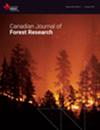加拿大东部以糖枫为主的混交林树苗密度模拟
IF 1.5
3区 农林科学
Q2 FORESTRY
引用次数: 0
摘要
树苗(胸高直径1.1 ~ 9.0 cm的树种)在森林生长发育中起着重要作用。它们的丰度和密度可导致特定的森林演替轨迹和生态系统特征。然而,在森林经营规划中考虑树苗是一个相对较新的课题,在森林生长模型中仍然很少被纳入。我们开发了10个物种群的树苗密度模型,目的是为森林管理者提供额外的工具,以支持开发更精确的预测系统。我们使用树木学和环境变量来模拟树苗密度和物种密度比。我们评估了用于树苗密度建模的泊松和伽马回归以及用于模型物种比率的零膨胀逻辑回归。我们对位于北美东北部阔叶林的永久样地进行了重复测量(从1982年到2019年)。结果表明,伽玛回归优于泊松回归。使用伽玛回归交叉验证的平均偏差为55茎·ha−1,相对百分比误差为2.5%,r2为0.43。种间小树密度比模型总体r2为0.93,种间平均r2为0.90 ~ 0.96。在检验的模型协变量中,适销大树的茎密度和纬度在两个模型中都是显著的。我们相信,我们开发的模式对森林管理规划和可持续的可销售生产是有用的。本文章由计算机程序翻译,如有差异,请以英文原文为准。
Modelling sapling density for sugar maple-dominated mixed stands of eastern Canada
Saplings (tree species whose diameter at breast height ranges from 1.1 to 9.0 cm) are important in forest growth and development. Their abundance and density can lead to specific forest successional trajectories and ecosystem characteristics. Yet, the consideration of saplings in forest management planning is a relatively new topic and is still rarely included in forest growth models. We developed sapling density models for 10 species groups with the objective of providing forest managers with additional tools to support the development of more precise prediction systems. We used dendrometric and environmental variables to model sapling density and species-wise density ratios. We evaluated Poisson and gamma regressions for the modelling of sapling density and zero-inflated logistic regressions to model species ratios. We used repeated measurements (from 1982 to 2019) from permanent sample plots located in hardwood forests in northeastern North America. Our results show that the gamma regression was superior to the Poisson regression. The cross-validated mean bias using gamma regression was 55 stems·ha −1 with a relative percentage error of 2.5% and an R 2 of 0.43. The species-wise sapling density ratio model had an overall R 2 of 0.93, and the species-wise mean R 2 ranged between 0.90 and 0.96. Among the examined model covariates, stem density of merchantable-sized trees and latitude were significant in both models. We believe that the models we developed can be useful for forest management planning and sustainable merchantable production.
求助全文
通过发布文献求助,成功后即可免费获取论文全文。
去求助
来源期刊
CiteScore
4.20
自引率
9.10%
发文量
109
审稿时长
3 months
期刊介绍:
Published since 1971, the Canadian Journal of Forest Research is a monthly journal that features articles, reviews, notes and concept papers on a broad spectrum of forest sciences, including biometrics, conservation, disturbances, ecology, economics, entomology, genetics, hydrology, management, nutrient cycling, pathology, physiology, remote sensing, silviculture, social sciences, soils, stand dynamics, and wood science, all in relation to the understanding or management of ecosystem services. It also publishes special issues dedicated to a topic of current interest.

 求助内容:
求助内容: 应助结果提醒方式:
应助结果提醒方式:


